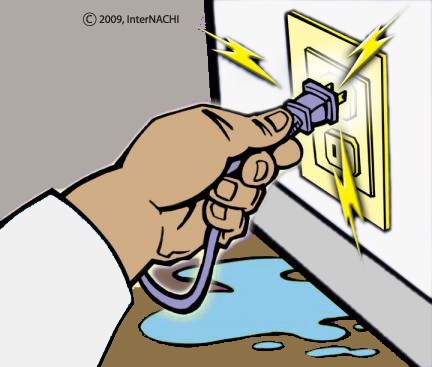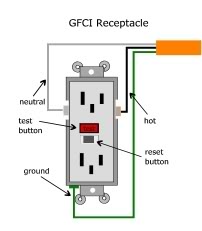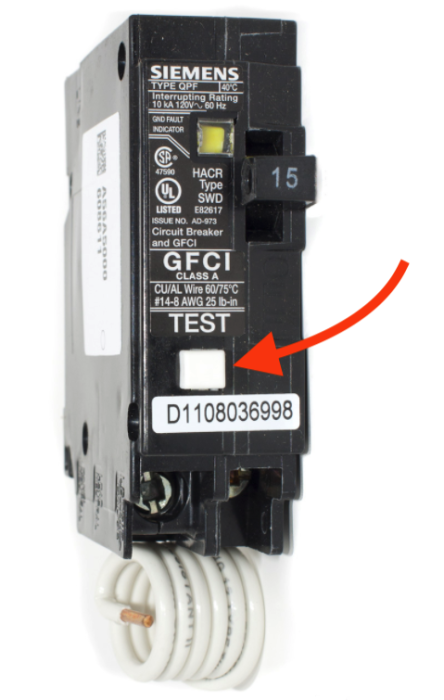What is a GFCI?
 GFCIs are designed to provide protection in such a situation, unlike standard circuit breakers, which guard against overloads, short circuits and ground faults. It is estimated that about 300 deaths by electrocution occur every year, so the use of GFCIs has been adopted in new construction, and recommended as an upgrade in older construction, in order to mitigate the possibility of injury or fatality from electric shock.
GFCIs are designed to provide protection in such a situation, unlike standard circuit breakers, which guard against overloads, short circuits and ground faults. It is estimated that about 300 deaths by electrocution occur every year, so the use of GFCIs has been adopted in new construction, and recommended as an upgrade in older construction, in order to mitigate the possibility of injury or fatality from electric shock.History
See a chart showing GFCI location history!
The first high-sensitivity system for detecting current leaking to ground was developed by Henri Rubin in 1955 for use in South African mines. This cold-cathode system had a tripping sensitivity of 250 mA (milliamperes), and was soon followed by an upgraded design that allowed for adjustable trip-sensitivity from 12.5 to 17.5 mA. The extremely rapid tripping after earth leakage-detection caused the circuit to de-energize before electric shock could drive a person's heart into ventricular fibrillation, which is usually the specific cause of death attributed to electric shock.
Modern Requirements
The 2020 NEC 210.8 (A) and the 2021 International Residential Code (IRC) E3902 contain similar additional updates relevant to GFCI use, as well as some exceptions for certain areas (follow the two preceding links to view exceptions):
All 125-volt through 250-volt receptacles installed in the locations specified in 210.8(A)(1) through (A)(11) and supplied by single-phase branch circuits rated 150 volts or less to ground shall have ground-fault circuit-interrupter protection for personnel.
- Bathrooms
- Garages and also accessory buildings that have a floor located at or below grade level not intended as habitable rooms and limited to storage areas, work areas, and areas of similar use
- Outdoors
Exception to (3): Receptacles that are not readily accessible and are supplied by a branch circuit dedicated to electric snow-melting, deicing, or pipeline and vessel heating equipment shall be permitted to be installed in accordance with 426.28 or 427.22, as applicable.
- Crawl spaces — at or below grade level
- Basements
Exception to (5): A receptacle supplying only a permanently installed fire alarm or burglar alarm system shall not be required to have ground-fault circuit-interrupter protection.Informational Note: See 760.41(B) and 760.121(B) for power supply requirements for fire alarm systems.Receptacles installed under the exception to 210.8(A)(5) shall not be considered as meeting the requirements of 210.52(G).
- Kitchens — where the receptacles are installed to serve the countertop surfaces
- Sinks — where receptacles are installed within 1.8 m (6 ft) from the top inside edge of the bowl of the sink
- Boathouses
- Bathtubs or shower stalls — where receptacles are installed within 1.8 m (6 ft) of the outside edge of the bathtub or shower stall
- Laundry areas
Exception to (1) through (3), (5) through (8), and (10): Listed locking support and mounting receptacles utilized in combination with compatible attachment fittings installed for the purpose of serving a ceiling luminaire or ceiling fan shall not be required to be ground-fault circuit-interrupter protected. If a general-purpose convenience receptacle is integral to the ceiling luminaire or ceiling fan, GFCI protection shall be provided.
- Indoor damp and wet locations
Testing Receptacle-Type GFCIs
 re they are working properly and are providing protection from fatal shock.
re they are working properly and are providing protection from fatal shock.If the "RESET" button does not pop out, the GFCI is defective and should be replaced.
Recognizing GFCI Breakers

